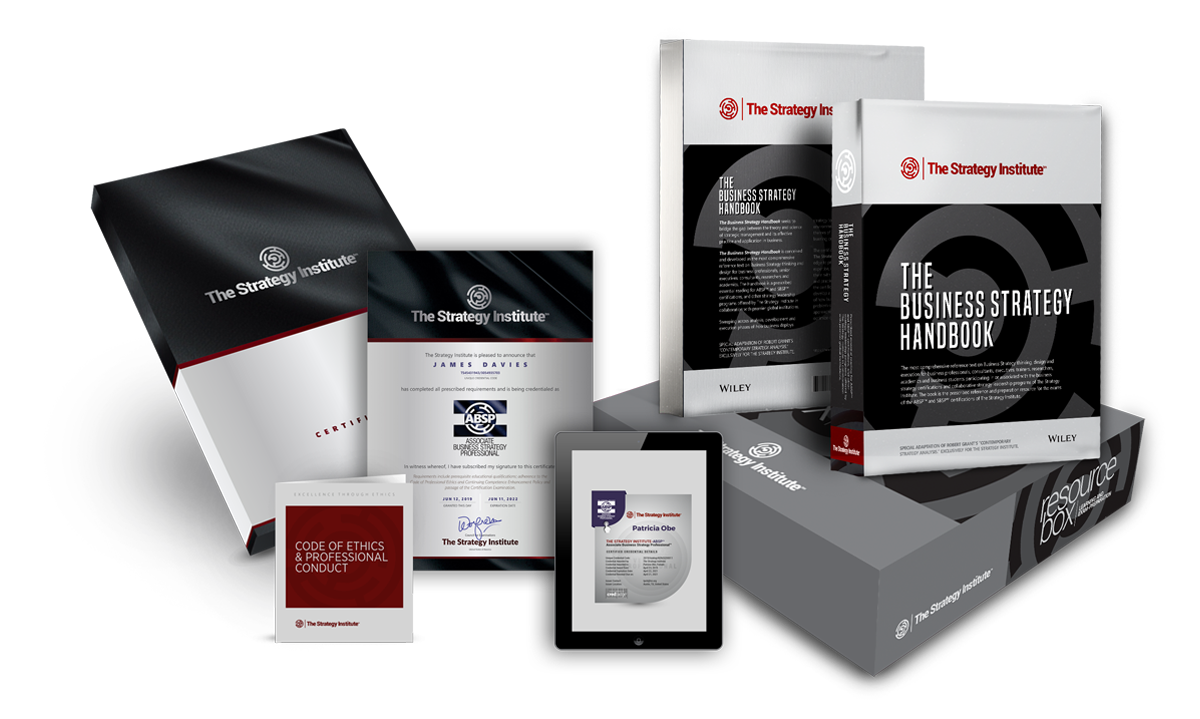Coverage of ABSP™ Exam
The ABSP™ certification exam aims to primarily evaluate conceptual and applied knowledge of the core principles, theories, frameworks and techniques of strategic analysis, strategy formulation and strategy execution at various levels in an organization across different stages in its life cycle. The exam also seeks to assess generic understanding of the dynamics of models and environments of business and industry. The ABSP™ certification exam, pursuant to the TSI body of knowledge, does not dwell much on the foundational science of strategic management per se, and instead focuses on aspects that define the core processes and approaches of identifying and managing problems and opportunities related to the health, survival and growth of businesses of organizations.
Candidates entering the ABSP™ program with a sound and clear awareness of the world of global business, and a foundational understanding of strategic management principles and process, generally experience swifter and deeper learning during their ABSP™ certification journey. Such candidates also find preparing effectively for the ABSP™ exam is much easier and faster.
ABSP™ exam features questions drawn from a wide selection of business strategy areas defined in the TSI body of knowledge as essential for individuals intending to be certified by TSI. Though the Business Strategy Handbook provided to all ABSP™ candidates is not exactly a training or exam-preparation manual, it does guide the framework and coverage of the ABSP™ certification exam. All ABSP™ examinees are strongly advised to refer to other books and reference material for smarter exam preparation.
Knowledge Areas & Topics
+
The Business Strategy Concept
5%
The Role of Strategy in Business Success; The Basic Framework for Strategy Analysis; The Business Strategy Building Process; Strategic Management of Not-For-Profit Organizations
+
Goals, Values, and Performance
5%
Strategy as a Quest for Value; Putting Performance Analysis into Practice; Values and Corporate Social Responsibility; Strategy and Real Options
From Environmental Analysis to Industry Analysis; Analyzing Industry Attractiveness; Applying Industry Analysis to Forecasting Industry Profitability; Using Industry Analysis to Develop Strategy; Defining Industries; Identifying Key Factors Driving Competitive Success in Industries
+
Competitive Analysis
7.5%
Extending the Five Forces Framework; Dynamic Competition: Hypercompetition, Game Theory, and Competitor Analysis; Segmentation and Strategic Groups
+
Analyzing Resources & Capabilities
10%
The Role of Resources and Capabilities in Strategy Formulation; Identifying Resources and Capabilities; Appraising Resources and Capabilities; Developing Strategy Implications
+
Organization Structure & Management Systems
5%
From Strategy to Execution; The Fundamentals of Organizing; Choosing the Right Organizational Structure
+
Competitive Advantage
10%
How Competitive Advantage Is Established and Sustained; Types of Competitive Advantage: Cost and Differentiation; Cost Analysis; Differentiation Analysis; Implementing Cost and Differentiation Strategies
+
Industry Evolution & Strategic Change
5%
The Industry Life Cycle; The Challenge of Organizational Adaptation and Strategic Change; Managing Strategic Change
+
Technology Industries & Innovation
5%
Competitive Advantage in Technology-intensive Industries; Strategies to Exploit Innovation: How and When to Enter; Standards, Platforms, and Network Externalities; Platform-based Markets; Implementing Technology Strategies: Creating the Conditions for Innovation; Accessing External Sources of Innovation
+
Competitive Advantage in Mature Industries
5%
Competitive Advantage in Mature Industries; Strategy Implementation in Mature Industries: Structure, Systems, and Style; Strategies for Declining Industries
+
Vertical Integration & the Scope of the Firm
5%
Transaction Costs and the Scope of the Firm; The Benefits from Vertical Integration; The Costs of Vertical Integration; Applying the Criteria: Deciding Whether to Make or Buy; Designing Vertical Relationships; Different Types of Vertical Relationship; Choosing among Alternative Vertical Relationships
+
Global Business Strategy
5%
Implications of International Competition for Industry Analysis; Analyzing Competitive Advantage in an International Context; Internationalization Decisions: Locating Production; Internationalization Decisions: Entering a Foreign Market; Multinational Strategies: Global Integration versus; National Differentiation; Implementing International Strategy: Organizing the Multinational Corporation
+
Diversification Strategy
5%
Motives for Diversification; Competitive Advantage from Diversification; Diversification and Performance; The Meaning of Relatedness in Diversification
+
Managing the Multibusiness Firm
5%
The Role of Corporate Management; Managing the Corporate Portfolio; Managing Linkages Across Businesses; Managing Individual Businesses; Managing Change in the Multibusiness Corporation; Governance of Multibusiness Corporations
+
External Growth Strategies
5%
Mergers and Acquisitions; Strategic Alliances
+
Trends in Business Strategy Management
5%
The New Environment of Business; New Directions in Strategic Thinking; Redesigning Organizations;The Changing Role of Managers
Business Strategy Cases of companies and industries
Learn the latest in the Art and Science of Business Strategy by earning ABSP™.
The ABSP™ Exam Format
A typical ABSP™ exam consists of 50 questions, with a mix of fact-based and critical analysis and judgment-based questions. Some exams may feature only one type of question.
TYPE A - FACT-BASED QUESTIONS
Fact-based questions directly test the exam taker's ability to recollect concepts, principles, techniques, and generally accepted practices correctly and precisely in contemporary business strategy. As exam-takers respond to these types of questions, they demonstrate an understanding of critical concepts and issues covered in the TSI body of knowledge. These questions are fact-based, with the answer options being clear statements, either clearly correct or incorrect. There is only one CORRECT answer, and exam-takers are scored only if the correct options are selected.
TYPE B - CRITICAL ANALYSIS AND JUDGMENT-BASED QUESTIONS
Critical analysis and judgment-based questions test the exam-taker's understanding of concepts, principles, and techniques at an advanced level and their ability to apply their critical analysis and judgment in gauging business strategy challenges. Ultimately, these questions contribute to the development of well-rounded business strategists. These questions have four answer choices, and ONLY one of these four would be incorrect. The rest of the three answers would be correct, but they represent varying levels of suitability for the situation expressed. The best of these three answers carries the maximum 10 marks, and the least suitable is the least – 5 marks. The third correct answer with mid-level suitability carries 7.5 marks. Exam-takers must choose only one of these four answer choices, and they are scored 0, 5, 7.5, or 10, depending on their choice of answer–option.
The ABSP™ Exam Design
The ABSP™ exam aims at validating candidates' potential to effectively deploy widely adopted concepts and techniques of business strategy and strategic thinking and analysis to improve their performance across the entire spectrum of functions in a typically large organization or a business system. The ABSP™ exam validates this potential by assessing candidates' conceptual, theoretical and applied knowledge of core and generally followed principles, frameworks, techniques and models of strategic analysis and decision-making in varying business contexts, scenarios and environments that organizations encounter across different stages in their life-cycle. The ABSP™ exam content is aligned to the TSI body of knowledge, which the TSI Business Strategy Handbook covers reasonably well. Indeed, since the business strategy space is extremely dynamic, all ABSP™ candidates are expected to also refer to external journals and books; listen to podcasts of experts and participate in professional development activities and events to enrich their perspective of strategy in business.
Qualifying the ABSP™ Exam
Usually, a cumulative score of 65%-70% on an ABSP™ exam can be deemed worthy of certification. However, an examinee's real, individual scores do not eventually decide the recommendation for a certification award. Instead, a score scaling and rationalization mechanism is used to make certification decisions to nullify geographic and environmental factors with potential to skew performance. As such, the certifying benchmark should not be used as a specific number to determine passing or failing performance on the exam.
Preparing for the ABSP™ Exam
ABSP™ is for young professionals aspiring to move to more challenging and higher-impact roles in their areas of professional specialization. ABSP™ exam, hence aligns to the TSI body of knowledge, which covers essential topics in which knowledge is necessary for ABSP™ candidates to prove their fitness for complex roles. It is critical that all ABSP™ candidates focus on widening their understanding of how the strategy of their organizations impacts the deliverables of their own roles, and hence relate more sharply to their KRAs at work. While the Business Strategy Handbook builds a very good mental framework of core concepts in business strategy to aid in preparing for the ABSP™ exam, additional external reading is also essential to improve awareness of current strategic thinking and strategic analysis trends. Business Strategy is an evolving discipline and will perhaps never become an exact science, which makes containing the entire practice into a single textbook impossible.
While ABSP™ candidates are advised to use the TSI Handbook on Business Strategy as their main reference for preparing for their ABSP™ exam, it is just one piece in preparation for the ABSP™ examination. Although a sizable number of questions in a typical ABSP™ exam are drawn from content which is available in the Handbook, the rest of the questions may be drawn from content from other sources. TSI therefore strongly advises all examinees to research other online and offline resources to increase their knowledge of concepts and awareness about how business strategy impacts various functions and decision-making in an organization.


 Click here to register for ABSP™
Click here to register for ABSP™
























